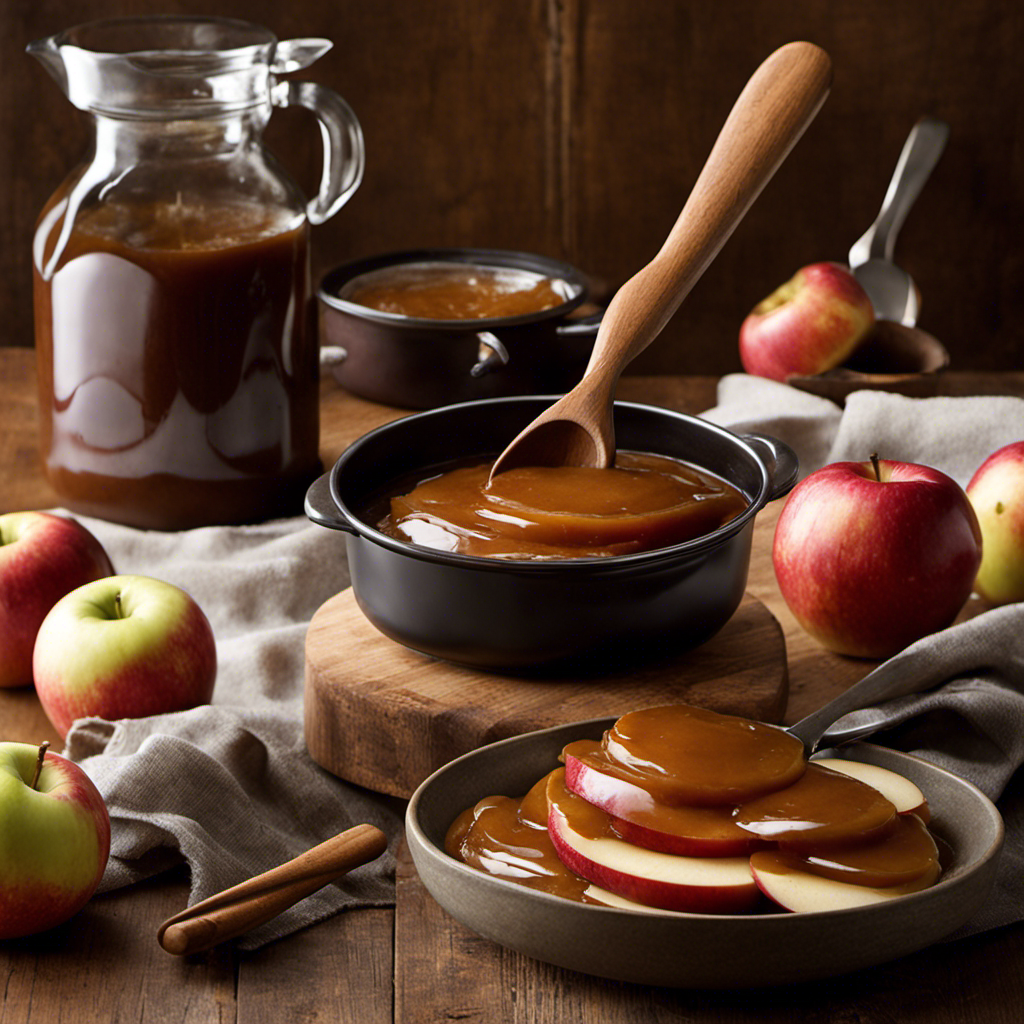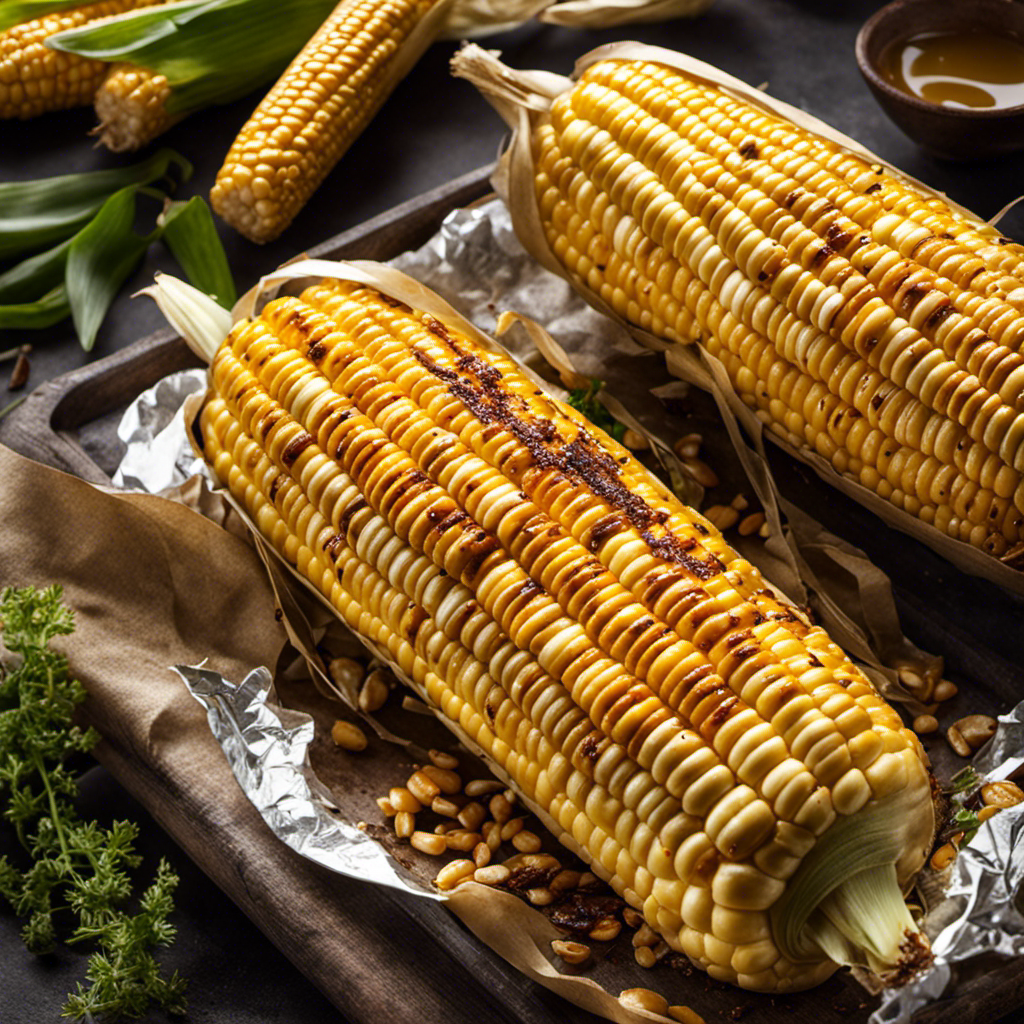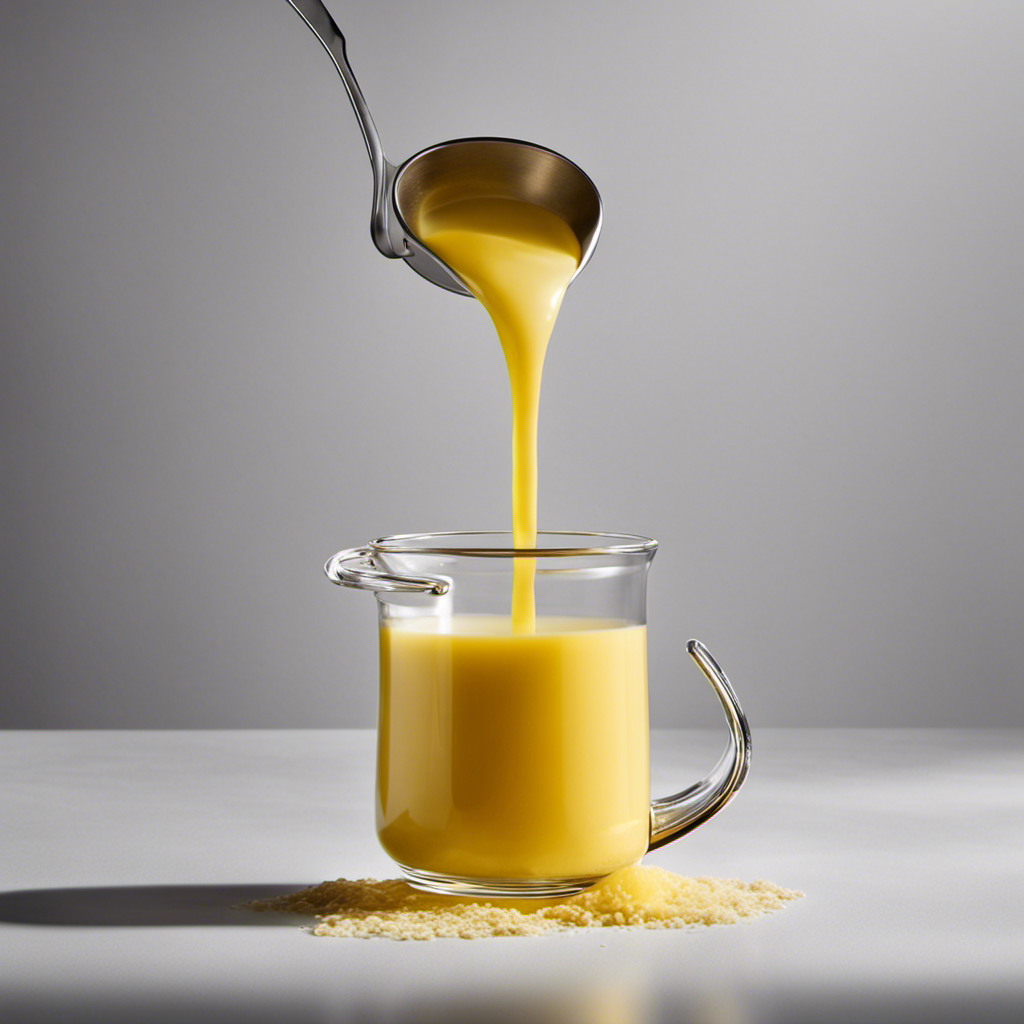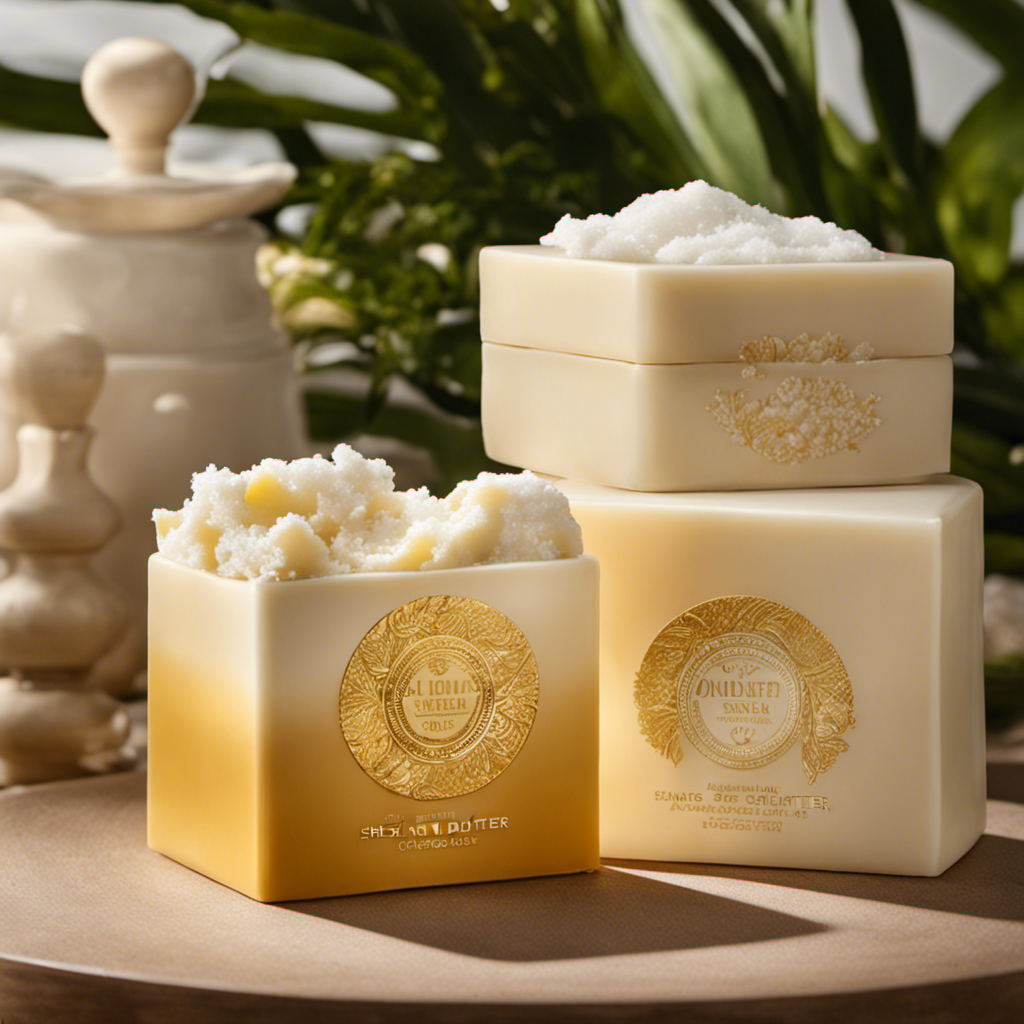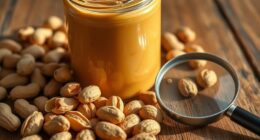I have discovered the key to making a deliciously rich apple butter that will delight your taste buds.
In this guide, I’ll walk you through the art of thickening apple butter using tried-and-true techniques.
From understanding the role of pectin to choosing the perfect apples, I’ll show you every step of the way.
Get ready to elevate your apple butter game to new heights with my expert tips and tricks.
Let’s dive in and thicken that apple butter to perfection!
Key Takeaways
- Pectin, a natural substance found in certain apple varieties like Granny Smith, Jonathan, and McIntosh, helps thicken apple butter during the cooking process.
- Cooking the apples on low heat for an extended period of time, stirring frequently, and using an immersion blender can help achieve a smooth and thick consistency.
- The right sugar-to-apples ratio is crucial for thickening apple butter, as sugar acts as a thickening agent and helps bind the natural pectin in the apples.
- Natural thickeners like chia seeds and ground flaxseed can be used to enhance thickness, improve the nutritional profile, and extend the shelf life of apple butter.
Understanding the Role of Pectin in Thickening Apple Butter
Pectin is a natural substance that helps thicken apple butter. When making apple butter, choosing the right apples is crucial for achieving the desired consistency. Certain apple varieties contain higher levels of pectin, which makes them ideal for thickening the butter.
The best apple varieties for this purpose include Granny Smith, Jonathan, and McIntosh. These apples have a higher pectin content, which helps the apple butter thicken naturally during the cooking process. Granny Smith apples, in particular, are known for their tartness and high pectin levels, making them a popular choice for apple butter.
Choosing the Right Apples for Thickening Apple Butter
When it comes to making apple butter, choosing the right apple varieties is crucial for achieving the desired thickness. Certain apple varieties, such as Granny Smith and Jonathan, are known for their high pectin content, which helps to naturally thicken the apple butter during the cooking process.
Additionally, employing the right cooking techniques can also contribute to achieving the desired thickness in the final product. Cooking the apples low and slow allows them to break down and release their natural juices, which helps to thicken the apple butter. Using an immersion blender to break down the apples further can also help to create a smoother and thicker consistency.
Best Apple Varieties
Choosing the best apple varieties is crucial for thickening apple butter. When it comes to making this delectable spread, not all apples are created equal. The best apple varieties for thickening apple butter are those that are high in pectin. Pectin is a natural thickening agent found in fruits, and it plays a key role in giving apple butter its desired consistency.
Apples such as Granny Smith, Jonathan, and McIntosh are known for their high pectin content, making them ideal choices for thickening apple butter. These varieties have a tartness that balances well with the sweetness of the butter, resulting in a rich and flavorful spread.
Now that we know the best apple varieties, let’s explore the cooking techniques for achieving the perfect thickness.
Cooking Techniques for Thickness?
To achieve the desired thickness in your apple spread, it’s important to cook the apples down slowly over low heat. This will allow the apples to release their natural juices and break down into a thick and luscious consistency.
One of the most important cooking tips for thickening apple butter is to choose apples with a high pectin content, such as Granny Smith or Jonathan varieties. Pectin is a natural thickening agent found in apples, and using apples with a higher pectin content will result in a thicker apple butter.
Another common problem when cooking apple butter is overcooking, which can lead to a burnt or caramelized flavor. To avoid this, it is crucial to stir frequently and monitor the heat to ensure the apples cook evenly without burning.
By following these cooking tips and troubleshooting common problems, you can achieve the perfect thickness in your apple butter.
Now, let’s explore some techniques for cooking apple butter to a thick consistency.
Techniques for Cooking Apple Butter to a Thick Consistency
You can achieve a thick consistency for your apple butter by cooking it on low heat for an extended period of time. Understanding the role of sugar in apple butter consistency is crucial for achieving the desired spreadable texture. Sugar acts as a thickening agent by helping to bind the natural pectin in the apples.
Here are some tips for cooking apple butter to a thick and spreadable consistency:
-
Start with a high sugar-to-apples ratio. This will ensure that there is enough sugar present to thicken the apple butter.
-
Cook the apple butter on low heat for several hours. This slow cooking process allows the sugar to dissolve and the apples to break down, resulting in a thick and smooth consistency.
-
Stir the apple butter frequently to prevent it from sticking to the bottom of the pot and to ensure even cooking.
The Importance of Proper Sugar Ratio in Thickening Apple Butter
Achieving the desired consistency for your apple butter relies heavily on having the proper ratio of sugar. The sugar not only adds sweetness but also acts as a thickening agent.
However, if you are looking for sugar alternatives, there are a few options to consider. One alternative is using honey, which can provide a natural sweetness while also helping to thicken the apple butter.
Another option is using maple syrup, which adds a rich flavor and helps in thickening as well. If you prefer a reduced-sugar version, you can use a sugar substitute like stevia or erythritol.
These alternatives may require some adjustments in terms of quantity, as they have different sweetness levels compared to regular sugar. Experimentation is key to finding the right balance and achieving the desired consistency in your apple butter.
Using Natural Thickeners Like Chia Seeds or Ground Flaxseed
When it comes to thickening options, chia seeds offer a natural and beneficial alternative. Not only do chia seeds have the ability to absorb liquid and form a gel-like consistency, but they also provide numerous health benefits due to their high nutritional content.
In addition to chia seeds, there are other alternative thickeners such as ground flaxseed that can be used in various recipes to achieve a desired thickness.
Benefits of Chia Seeds
Adding chia seeds is a simple way to enhance the thickness of apple butter. Chia seeds are not only a great source of fiber and omega-3 fatty acids, but they also have a unique ability to absorb liquid and form a gel-like consistency. When incorporated into recipes, chia seeds can provide several benefits.
- Increased thickness: Chia seeds absorb liquid and expand, creating a thicker texture in the apple butter.
- Improved nutritional profile: Chia seeds are rich in essential nutrients, including calcium, iron, and antioxidants, which can boost the overall nutritional value of the apple butter.
- Enhanced satiety: The high fiber content in chia seeds can help promote feelings of fullness and reduce cravings.
- Extended shelf life: Chia seeds have natural preservative properties, which can help prolong the shelf life of the apple butter.
Now, let’s explore some alternative thickening options for apple butter.
Alternative Thickening Options
One option you can consider is using cornstarch as an alternative thickening agent for your apple butter recipe. Cornstarch is a popular choice because it is a reliable thickener that is widely available and easy to use. However, there are both pros and cons to using cornstarch.
One of the main advantages of using cornstarch is its ability to create a smooth and glossy texture in your apple butter. It also has a neutral flavor, so it won’t alter the taste of your final product. Additionally, cornstarch is a gluten-free option, making it suitable for those with dietary restrictions.
On the other hand, cornstarch can sometimes create a slightly cloudy appearance in your apple butter. It may also break down if exposed to high heat for an extended period of time. Furthermore, cornstarch may require longer cooking times to fully thicken the apple butter.
Overall, using cornstarch as a thickening agent for apple butter can be a viable option, but it’s important to consider the potential drawbacks and adjust your cooking process accordingly.
Incorporating Cornstarch or Arrowroot Powder to Thicken Apple Butter
To thicken your apple butter, you can incorporate cornstarch or arrowroot powder. These two options provide excellent thickening properties and can enhance the texture of your apple butter.
When comparing the two, cornstarch is a more commonly used thickener due to its availability and affordability. It creates a smooth and glossy texture, giving your apple butter a more traditional appearance.
Arrowroot powder, on the other hand, is a gluten-free alternative that can create a slightly lighter and less opaque texture. It is also known for its neutral flavor, which allows the natural flavors of the apple butter to shine through.
Ultimately, the choice between cornstarch and arrowroot powder depends on personal preference and dietary restrictions.
Simmering Apple Butter for a Longer Time to Achieve Thickness
Simmering the apple butter for a longer time will result in a thicker consistency. To ensure success, it is crucial to choose the right pot for simmering. Opt for a heavy-bottomed pot that distributes heat evenly, preventing hot spots that may cause burning or uneven cooking. A stainless steel or enameled cast iron pot would work well.
Additionally, using a slow cooker can be an effective method for thickening apple butter. The slow, steady heat allows the flavors to develop and the sauce to thicken naturally over time. Simply transfer the apple butter to a slow cooker, set it to low heat, and let it simmer for several hours, stirring occasionally.
This gentle cooking process will give you a rich and thick apple butter with minimal effort.
Refrigeration and Other Cooling Methods to Thicken Apple Butter
If you’re looking to cool down your apple butter quickly, try placing the pot in an ice bath and stirring occasionally until it reaches your desired thickness. Refrigeration offers several benefits when it comes to thickening apple butter.
Here are some methods you can use to cool and thicken your apple butter effectively:
-
Ice Bath Method: Place the pot of apple butter in a larger bowl filled with ice and cold water. Stir occasionally to distribute the cold temperature evenly and promote thickening.
-
Refrigerator Method: Transfer the apple butter to a shallow, wide container and refrigerate for several hours or overnight. The cold temperature will cause the apple butter to thicken gradually.
-
Gelatin Addition: Another option is to add a small amount of gelatin to the apple butter while it is still warm. The gelatin will help stabilize and thicken the mixture.
-
Chilling and Resting: Allow the apple butter to cool at room temperature and then refrigerate for a few hours. This will allow the flavors to meld and the apple butter to thicken naturally.
Frequently Asked Questions
Can I Use Store-Bought Apple Butter as a Thickening Agent for Making Homemade Apple Butter?
Yes, you can use store-bought apple butter as a thickening agent for making homemade apple butter. However, using apple sauce instead of apple butter or exploring alternatives can also be effective in achieving the desired thickness.
Are There Any Non-Dairy Alternatives to Thicken Apple Butter?
I found some non-dairy alternatives that can be used as thickening agents for apple butter. These options include arrowroot powder, tapioca starch, or agar agar. They provide the desired thickness without using dairy products.
Can I Use Unripe Apples to Make Apple Butter?
Using unripe apples as substitutes in apple butter can lead to a thinner consistency. Alternative thickening methods, such as reducing the mixture on low heat or adding pectin, can help achieve a thicker texture.
Can I Use a Slow Cooker to Make Apple Butter and Achieve a Thick Consistency?
Yes, using a slow cooker to make apple butter can result in a thick consistency. I once used a slow cooker and the apple butter turned out perfectly thick and smooth.
Can I Use Gelatin as a Natural Thickener for Apple Butter?
I wouldn’t recommend using gelatin as a natural thickener for apple butter. There are other traditional thickening methods, such as simmering the mixture for a longer period of time or adding pectin.
Conclusion
In conclusion, thickening apple butter requires understanding the role of pectin, choosing the right apples, and utilizing various techniques.
Interestingly, did you know that a medium-sized apple contains about 4 grams of dietary fiber? This visual representation highlights the natural thickening properties of apples, making them perfect for creating a thick and delicious apple butter.
By incorporating natural thickeners like chia seeds or cornstarch, and simmering the mixture for a longer time, you can achieve the desired consistency.
So go ahead and enjoy your homemade, thick apple butter!
